Mobile gaming is everywhere you look, and successful teams earn real support from brands in the mobile eSports ecosystem. Everyone wants to know what actually powers these partnerships.
With mobile eSports ecosystem deals shaping players’ lives and entire organizations, understanding sponsorship mechanics can open doors. The process follows rules — but it’s not guesswork or luck.
Explore how sponsorships are identified, negotiated, and executed in the mobile eSports ecosystem. Get practical advice and observe what sets winning team-brand deals apart every season.
Understand What Brands Want Before You Apply
When chasing sponsorships in the mobile eSports ecosystem, knowing brand motivation gives you an edge. Sponsors track measurable results, not just flashy logos or hashtags in passing tweets.
Effective sponsorship requests reflect a keen understanding of deliverables. This means showing specifically what brands can expect from your team’s audience reach, content, and engagement.
The Value Swap: Why Sponsors Pay
Brands spend money to tap into real communities. In the mobile eSports ecosystem, sponsors want loyal, active fans — not silent bystanders. Teams bring access to highly engaged gamers.
Sponsorship goes where visibility converts into sales or lasting awareness. Think about how you’d explain: “We have 50,000 Discord members and 70% click our partner links monthly.” That speaks volumes.
When teams can say, “We generated 2,000 interactions for our gear sponsor’s discount code in three days,” that clarity builds confidence. Always back up your pitch with numbers and true engagement.
Pitch Materials That Stand Out
Successful teams in the mobile eSports ecosystem use clear, concise pitch decks. These include key stats such as social reach, previous brand partnerships, and tournament results — all with proof.
Include a page in your pitch deck showing followers’ real comments. For example, if fans ask, “When’s the next sponsor drop?” show that buzz. Engagement tells a stronger story than vanity metrics alone.
Showcase your consistency as a team: state your streaming schedule, event attendance, and recent accomplishments. This reassures brands you’re a steady, reliable partner in the mobile eSports ecosystem.
| Sponsor Goal | Team Action | Measurement Method | Next Step for Team |
|---|---|---|---|
| Brand Awareness | Display logos on stream overlays | Viewer impressions, social shares | Add logos to every stream header |
| Product Activation | Host live product unboxing | Viewer engagement, link clicks | Plan regular product streams |
| Consumer Trust | Give first-person reviews | Fan feedback, discussion in chat | Encourage team members to review gear |
| Direct Sales | Share exclusive promo codes | Track sales tied to team code | Negotiate commission model |
| Event Activation | Join sponsor-branded tournaments | Spotlight in recap articles, highlight reels | Create event-specific content for sponsors |
Building Sponsor Relationships That Last
Focusing on what brands need makes you more appealing. The mobile eSports ecosystem rewards reliability and honest communication above all other traits in partnership deals.
Sustaining relationships requires check-ins, feedback, and timely reporting. Don’t disappear after the contract — keep sponsors closely involved in activations and fan outreach.
Negotiating Deliverables and Expectations
Before signing anything, clarify all deliverables. Sponsors want specifics: “ten Instagram posts,” “weekly stream shoutouts,” or “three tournament appearances.” Confirm scope so everyone is on the same page.
If a team says, “Here’s what we’re promising and here’s when we’ll deliver,” sponsors feel secure. Avoid vague terms — detail everything so confusion never blocks your progress.
- Draft a deliverable checklist to clarify timelines, which posts go live, and who approves content, so nothing slips through the cracks during a campaign.
- Schedule progress updates after each event, explaining what worked and what needs adjustment, to keep the partnership transparent and adaptable.
- Set up direct messaging between your lead player and sponsor contact to quickly solve problems, respond to feedback, and show immediate engagement with requests.
- Email regular short reports (don’t wait for sponsor requests), outlining key achievements, media mentions, and deployed sponsor tags so value remains front and center.
- Include sponsor reps on your Discord or chat for live event access—they can watch real fan reactions and give instant feedback during broadcasts.
Every step above keeps your mobile eSports ecosystem partnership solid and growing. Direct action replaces confusion so both sides see gains, not just promises.
Evaluating Partnership Success
After campaigns, compile stats: clicks, conversions, chat sentiment, and new followers. Sharing transparent results strengthens trust and helps sponsors renew for another season.
Example recap: “Our fans used your promo code 320 times last week. We created six posts and grew Discord by 500 members since the last event.” Specific numbers stand out.
- Track unique code redemptions weekly to analyze trends and maximize sponsor investment with proven ROI, ensuring your team outperforms vague marketing impressions.
- Survey community sentiment post-campaign, using polls and chat highlights, to understand real impact and demonstrate deeper influence to sponsors for future discussions.
- Measure engagement rates on every promotional post across platforms, showing sponsors which types of content hit hardest and where their brand fits best with your style.
- Integrate UTM links in posts to attribute traffic accurately—making sponsorship value unmistakable in your mobile eSports ecosystem portfolio.
- Compile ‘highlight reels’ of sponsor engagement, showing moments where their mention led to chat spikes or purchases to tell a visual story in your reports.
Deliver these results quickly after the campaign, making your team easy to work with and keeping renewal conversations productive in the mobile eSports ecosystem.
Sponsorship Types and What Each Means for Teams
Understanding sponsorship categories helps teams tailor their approach. In the mobile eSports ecosystem, each type comes with unique expectations, so choose based on fit and resources.
Cash, in-kind, and event sponsorships all look different on paper and in contract negotiations. Each carries distinct benefits and points to watch as you build your game plan.
Cash Sponsorship Explained
The most sought-after arrangement is direct funding, exchanged for precise visibility. A brand pays teams in the mobile eSports ecosystem a set sum for banners, shoutouts, or custom content.
A sample script: “We provide you six monthly ad slots on Twitch and daily Twitter tags. You sponsor our travel and pay a fixed fee.” Everyone wins when each party knows the deliverables.
Teams using cash sponsorship need to document everything with receipts, screenshots, and post-campaign breakdowns. This transparency encourages sponsors to stick with your team longer.
In-Kind and Gear Sponsorship
Brands sometimes supply phones, tablets, accessories, or in-game currency. Teams promote products authentically, saying, “Here’s what we use—and why,” sharing videos and unfiltered feedback.
“We play with these cases because they survive daily drops,” reads stronger than generic praise. Real stories create value for brands and persuade future sponsors in the mobile eSports ecosystem.
Log gear received, post usage snapshots, and create recurring reviews, showing sponsors their investment lives on long after the first post.
Event-Driven Sponsorship Partnerships
Brands may back tournaments, host pop-ups, or sponsor exclusive matches. Teams help produce themed content, “shout out” sponsor names, or create custom game modes during livestreams.
In the mobile eSports ecosystem, event sponsors boost exposure but require teams to plan logistics ahead. Specific deliverables could be in-person appearances or scheduled Q&A sessions with fans.
Teams must debrief after every event, collecting photos and testimonials, and sending detailed recaps so brands see impact and consider future investments.
Getting Ready for Sponsorship Contact: Team Checklist and First Steps
Success in the mobile eSports ecosystem starts with preparation. Teams must polish every aspect of their digital presence before sponsors reach out. Your first impression begins before the call.
Start with a simple checklist focused on actionable tasks, so you’re ready before responses start rolling in — or missed messages hurt your chances.
- Organize your streamer bios and keep them updated with roles, major accomplishments, and current game stats, ensuring sponsors see an active, reliable squad.
- Set a regular posting calendar across Twitter, Instagram, and YouTube so brands expect steady, relevant content that lets them preview future activations before committing.
- Pin highlight reels of your best matches, major wins, or “top fan reactions” to each profile so sponsors see evidence of engagement, not only numbers in a spreadsheet.
- Enable business contact options on all socials, making it easy for sponsors to reach out with collaboration opportunities without digging for your email.
- Template your sponsorship pitch in advance, with placeholders for stats, links, and social proof so you can quickly personalize and send applications without stalling.
When teams follow these steps, first impressions stay sharp and ready to convert interest into partnerships in the mobile eSports ecosystem.
Common Mistakes That Risk Sponsor Interest
Teams sometimes lose sponsorships due to preventable errors in the mobile eSports ecosystem. Avoiding these pitfalls keeps brands engaged and secures long-term deals. Here’s what not to do.
Lack of reporting, inconsistent branding, and ignoring sponsor feedback create tension. Brands drop teams that don’t deliver clear value quickly or respect agreed-upon timelines.
Over-Promising and Under-Delivering
Promising “viral” results without strategy frustrates sponsors. Saying, “We’ll go viral every week,” without examples or recent wins undermines trust. Stick to realistic, proven deliverables every cycle.
Set expectations by referencing similar past activations: “Last campaign, we drove 800 unique clicks in three days with two Twitter threads and an Instagram Story series.”
If results ever slip, immediately communicate and propose a fix: “We missed yesterday’s stream, but we set up a makeup match for Saturday.” Quick action keeps sponsors happy in the mobile eSports ecosystem.
Neglecting Brand Alignment and Voice
Teams using off-brand language confuse fans and sponsors. Adapt every message to fit the sponsor’s preferred tone. “We’re thrilled by our tech gear—no cap!” matches some sponsor styles, but not all.
Get sign-off for any meme posts, jokes, or dramatic stunts before sending. “Can we run this TikTok?” Simple approvals reduce risk while encouraging creativity with brand boundaries clear up top.
Maintain sponsor documentation in your team chat so everyone stays on-message and respects the sponsor’s investment in the mobile eSports ecosystem.
Real World Scenarios: Securing and Growing Sponsor Deals
By understanding realistic sponsor conversations, teams in the mobile eSports ecosystem see what works in practice, not just theory. You’ll recognize proven scripts for moving from cold outreach to multi-event partnerships.
For example, a team replies instantly to a sponsor’s Instagram DM: “Thanks for reaching out! Here are our last three Twitch highlight clips and our fan engagement stats from April.”
From First Contact to Signed Agreement
The sponsor asks, “Can we hop on a call next Thursday?” The team responds, “Absolutely. Here’s our availability. We’ll prepare stats and a short Q&A for our captain.”
On the call, the team explains how their audience matches the sponsor’s ideal gamer: “Our viewers are ages 16–25, love FPS games, and buy new accessories quarterly.”
The meeting ends with a basic agreement: “Let’s test a one-month Instagram and YouTube campaign. We’ll track code usage and send recaps each Friday.”
Extending Partnerships Beyond the First Contract
As the campaign succeeds, the sponsor suggests: “Can your squad join our launch event next month?” The team replies, “We’d love to. We’ll record live reactions and share a TikTok reel.”
Each successful collaboration adds to the team’s sponsorship resume in the mobile eSports ecosystem, making future pitches sharper and opening doors to more lucrative offers.
Teams who evolve and adapt with sponsors, taking feedback seriously and being responsive, win the next round of discussions with competitive advantage.
Adapting Your Approach as the Mobile eSports Ecosystem Grows
The mobile eSports ecosystem keeps changing, so successful teams and sponsors adjust strategies as new games and platforms gain traction worldwide. Stay flexible while tracking trends closely.
This adaptability shows in outreach scripts, campaign planning, and tech adoption. The top organizations update their style and materials quarterly, not just once per year.
Teams who scan for new sponsor categories — health tech, apparel, in-game advertising — end up with more opportunities and less direct competition.
Research the next wave: “Player nutrition brands are reaching out more, so we’re adding hydration product reviews to our content plan this summer.”
Stay in tune with the mobile eSports ecosystem’s evolving needs, and you’ll keep your sponsorship strategy future-ready while building reliable, rewarding relationships.



